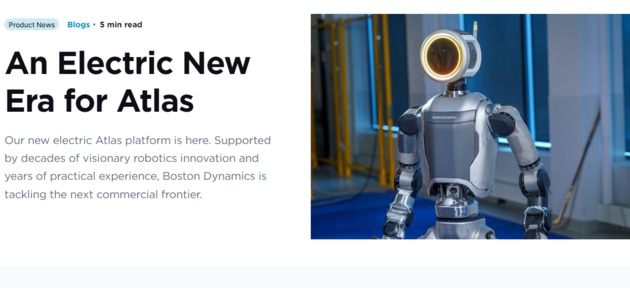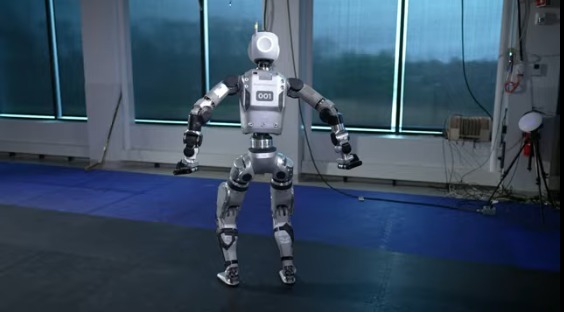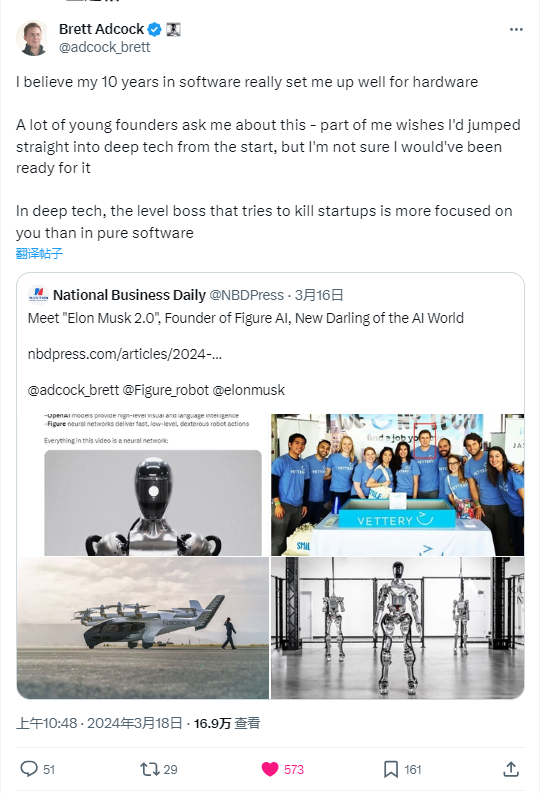
Photo/ Boston Dynamics
For nearly a decade, Atlas has captured our imaginations, inspired the next generation of robotics experts, and pushed the boundaries of what's possible in the field. Now, it's time for our hydraulic robot Atlas to take a bow and reflect on all that we've accomplished together on the Atlas platform.
Accompanying this text is a roughly 3.5-minute farewell video of the hydraulic Atlas. As a pioneer in humanoid robotics, the hydraulic Atlas has been constantly pushing the limits since its inception, from walking on uneven terrain to backflipping, each advancement nothing short of breathtaking. In the farewell video, Atlas performs one last show: jumping, running an obstacle course, backflipping, and dancing... As of press time, the video has been viewed nearly 950,000 times.
As Boston Dynamics announces the retirement of the hydraulic Atlas, one era is coming to a close, and another new chapter is unfolding.
The day after the hydraulic Atlas "retired," Boston Dynamics announced that it would be releasing a "stronger, more dexterous, and more agile" electric Atlas, which will be more powerful than its predecessors, have a wider range of motion, and even "exceed human capabilities" in its movement. The company plans to showcase the capabilities of this robot in the coming months and years.
Farewell, Hydraulic Atlas!
The news of the "retirement" of the hydraulic Atlas has sent shockwaves through the foreign media, with major overseas technology media outlets such as The Verge using phrases like "an era is over" and "Boston Dynamics has bid farewell to the world's most dynamic and groundbreaking humanoid robot Atlas" to describe Boston Dynamics' decision.
It should be noted that Atlas is not Boston Dynamics' only robot product, the company also has the Spot quadruped robot and the Stretch warehouse robot.
Development of the Atlas humanoid robot began in 2009 with a $26 million contract between Boston Dynamics and the U.S. military. Funded by the Defense Advanced Research Projects Agency (DARPA), the robot was designed from the outset to perform search and rescue missions, with the goal of entering areas that are unsafe for humans and performing a variety of tasks.
On July 11, 2013, Boston Dynamics first unveiled a bipedal robot, 6.2 feet tall and weighing 330 pounds (about 149 kg). At the time, the robot was called PETMAN, but was later renamed Atlas. As development progressed, Atlas achieved a series of incredible feats, starting with walking like a normal person, then walking on rough terrain, followed by the ability to run, dance, carry cargo, backflip, and even maintain balance when hit with a stick. The latest hydraulic Atlas is also a major improvement over the first generation, standing 5 feet tall and weighing 196 pounds (about 89 kg), more dexterous and agile.
DARPA notes: "Atlas is one of the most advanced humanoid robots ever built, but it is essentially a physical shell for the software brain and nerves developed by the team."

Original Atlas rendering and subsequent four generations of robots
Photo/Boston Dynamics website
Unlike traditional robots and electric-powered robots like Tesla's Optimus, the "retired" Atlas is powered by a dedicated battery and uses a hydraulic system with 28 hydraulic joints driven by hydraulic actuators. Hydraulic drive works by using a hydraulic pump to compress liquid to high pressure, which then does work on the output system to generate force. Due to its high torque density, hydraulics can make robots very powerful, and the hydraulic-based design allows hydraulic pressure to be easily transmitted through pipes to multiple remote locations.
With advanced control algorithms, the hydraulic Atlas can move at speeds of up to 2.5 meters per second, and can also strategically plan complex whole-body movements and seamlessly adapt to its surroundings.
However, hydraulic systems are not very energy efficient, and the system also has drawbacks such as a large number of parts, a complex manufacturing process, and a relatively slow response speed. Due to the complexity of the hydraulic system, the hydraulic Atlas occasionally experiences cylinder failures and oil leaks. In the farewell video, Atlas's front flip results in a low landing posture, causing it to fall to the ground, with hydraulic oil spraying from its knees. In addition, to commercialize them, hydraulic-powered robots need to overcome challenges such as high maintenance and manufacturing costs.
Boston Dynamics Announces New Plans
On April 17, local time, Boston Dynamics announced in an official blog post titled "A New Electric Era for Atlas" that the company will launch an electric version of Atlas, which will be more powerful than its predecessors, have a wider range of motion, and even be able to move "beyond human capabilities."
"The electric Atlas is stronger, more dexterous, and more agile. It may resemble the human form factor, but we are equipping the robot to move in the most efficient way possible to complete tasks, rather than being constrained by the human range of motion," Boston Dynamics wrote in the post.
In the video accompanying the blog post, the electric Atlas robot folds up from a lying position, then walks towards the camera and rotates its head. Its limbs, torso, and head can all move 360 degrees, giving it a wide range of motion.

Photo/ Boston Dynamics
Boston Dynamics said that its parent company Hyundai's next-generation car manufacturing technology is the "perfect proving ground for the new applications of the electric Atlas." Boston Dynamics plans to demonstrate the robot's true capabilities in the coming months and years, and will first test the electric Atlas with a small group of partners.
Boston Dynamics said it is working on new gripper systems to ensure that the new Atlas can meet a variety of commercial needs, while further improving its ability to lift and move a variety of heavy and irregular objects based on its previous parkour robots. The company said the new Atlas will be more powerful than its predecessors and is confident that it can commercialize this new humanoid robot.
In fact, Boston Dynamics has been working on commercializing Atlas for many years, and this trend has accelerated further since Hyundai acquired it in 2021. However, the complex hydraulic robot is not consumer-friendly. Early videos showed that Boston Dynamics had been trying to use Atlas for tasks in warehouses and other places, but it was not as successful as its quadruped robot Spot.
In recent years, the humanoid robot industry has also seen rapid development, with a number of tech giants entering the market.
Tesla has released several videos of performance updates and iterations of its humanoid robot Optimus. The Optimus robot's current force control is relatively precise and sensitive, and its enhanced environmental perception and memory capabilities allow it not only to see the road, but also to remember it. Moreover, Optimus can perform end-to-end action control based on human action examples.
The American startup Figure AI recently released a demo of its first robot powered by an OpenAI large model. In the video, Figure 01 uses only one neural network but can follow human commands, handing over apples to humans, tidying black plastic bags into a box, and placing cups and dishes on a dish rack. In a recent reply to a tweet from the NBD, Figure CEO Brett Adcock said that more than a decade of experience in the software industry has laid the foundation for crossing into the hardware field and has accumulated a deeper understanding for the development of humanoid robots.

Photo/X
Multiple teams at Apple are also researching and advancing personal robot technology, which has the potential to become one of Apple’s “next big things.”
The competition in the humanoid robot field is becoming increasingly fierce, and Boston Dynamics’ path to commercialization will face significant challenges.


 川公网安备 51019002001991号
川公网安备 51019002001991号





